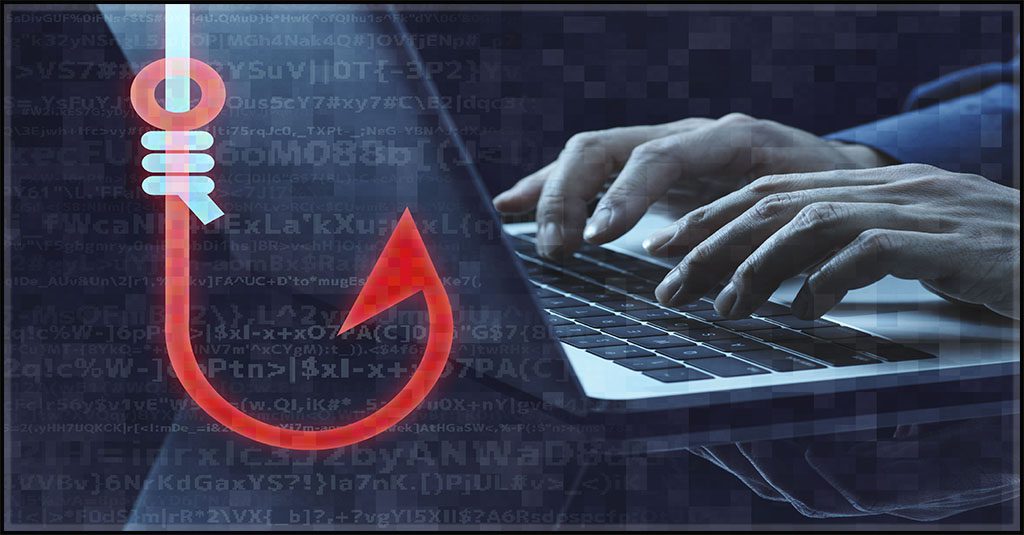What Is Spoofing? How It Works, Types, Detection & Prevention

Cybercriminals are making use of every trick in the book, old and new, to launch damaging cyberattacks against businesses across the world, and spoofing has become a key weapon in their arsenal. So, understanding the nuances of spoofing is crucial for every IT professional and business owner.
Spoofing, a deceptive tactic used by cybercriminals to disguise communication from an unknown source as being from a known, trusted source, can lead to significant security breaches. In this comprehensive blog, we delve into the world of spoofing to shed light on why it’s a critical topic for everyone to grasp. We will unravel how spoofing operates, explore the various forms it takes and offer insights into detecting these cunning attacks.
As we navigate the complexities of spoofing, we will also introduce robust security awareness training and email security solutions, like BullPhish ID and Graphus, designed to fortify your defenses against these deceptive attacks. We encourage you to learn more about ID Agent’s lineup of world-class security tools that protect against a wide range of cyber threats (including spoofing) by booking a demo to see them in action. These resources will help you better understand and combat spoofing attacks.

What should you be looking for in an EDR solution? This checklist helps you make a smart choice! GET IT>>
What is spoofing?
Spoofing, in the realm of cybersecurity, refers to the art of deception where a malicious party disguises itself as a known or trusted entity to gain unauthorized access, spread malware, steal data or launch attacks. It’s a technique that leverages social engineering at its core, manipulating human psychology to breach security protocols. This threat is particularly pertinent in today’s digital age, where the integrity of communication channels and data authenticity are foundational to cybersecurity.
At the heart of spoofing lies the exploitation of trust. Cybercriminals often use spoofing to masquerade as legitimate sources, such as reputable companies or familiar contacts, thereby tricking individuals or systems into revealing sensitive information, clicking on malicious links or unknowingly granting access to secure networks. The harm caused by spoofing extends beyond individual attacks, as it can undermine the overall trust in digital communications and transactions.
Understanding and recognizing spoofing attacks is crucial. These can manifest in various forms, including email spoofing, caller ID spoofing, website spoofing and IP address spoofing, among others. Each type has its unique methods and targets, but they all share the common goal of deceiving the victim into believing they are interacting with a trusted entity.

Affordable, automated penetration testing is a game-changer. Learn about it in our buyer’s guide! GET GUIDE>>
What is the difference between spoofing and phishing?
Understanding the nuances between spoofing and phishing comes in handy when training users to improve your organization’s cyber resilience. Here’s a brief comparison of the two.
| Aspect | Spoofing | Phishing |
| Definition | Spoofing involves disguising communication from an unknown source as being from a known, trusted source. | Phishing is a broader strategy used to trick individuals into divulging sensitive information or clicking malicious links. |
| Primary objective | To gain trust by impersonating a legitimate source. | To deceive individuals into compromising their security by exploiting the established trust, often through spoofing. |
| Technique | Often involves changing sender information in emails, manipulating caller IDs or creating fake websites. | Typically includes sending deceptive emails that appear legitimate, often made credible through spoofing. |
| Target | Systems and individuals, to make them believe they are interacting with a trusted entity. | Individuals, aiming to extract sensitive information like login credentials or financial data. |
| Methodology | More technical, focusing on the alteration of communication or data. | More psychological, leveraging social engineering to manipulate human behavior. |
Check out our on-demand webinar to learn about the top phishing scams employees fall for. The webinar highlights real-life phishing scams that have cost businesses dearly and reveals phishing simulations that employees frequently fall victim to.

Every business faces insider risk, from employee mistakes to malicious acts. Learn how to mitigate it. DOWNLOAD EBOOK>>
How does spoofing work?
Spoofing attacks manipulate the identity of a communication source to masquerade as a trusted entity. This deception is not just technical but psychological, exploiting the human tendency to trust familiar sources. The effectiveness of spoofing lies in its ability to bypass initial skepticism, leading victims to reveal sensitive information or grant access to secure networks.
These attacks have proliferated across various media, including email, text and phone calls, adapting to different communication channels to maximize their deceptive potential. In email spoofing, for example, attackers alter email headers to make messages appear from legitimate sources. Text message spoofing can manipulate sender information to deliver deceptive SMS. Similarly, phone or caller ID spoofing can trick victims into believing they are speaking with trusted individuals or organizations.

See the challenges companies face & how they’re overcoming them in The Kaseya Security Survey Report 2023 DOWNLOAD IT>>
What is an example of spoofing?
A typical email spoofing attack might unfold as follows:
- Preparation: The attacker chooses a target individual or organization and conducts thorough research to identify a trusted contact or entity familiar to the target.
- Email header manipulation: Using specialized software, the attacker alters the email header, changing the “From” address to mimic the trusted contact’s email address.
- Crafting the message: The email is crafted to appear legitimate, often including urgent or enticing content to prompt immediate action from the recipient.
- Sending the email: The spoofed email is sent to the target, who, believing it to be from a known source, is more likely to trust its contents.
- Action by target: The target interacts with the email, such as clicking a link, downloading an attachment or replying with confidential information, leading to potential security breaches or data theft.
By understanding the mechanics behind spoofing attacks, individuals and organizations can better prepare and protect themselves from these deceptive practices.

Learn how to spot today’s most dangerous cyberattack & get defensive tips in Phishing 101 GET EBOOK>>
Types of spoofing
Spoofing attacks, taking on many forms, can infiltrate various communication mediums. Each type has unique characteristics, making them distinct yet equally dangerous.
Email spoofing
Email spoofing involves forging an email header so that the message appears to come from a known, legitimate source. It tricks recipients into thinking the email is from a trusted sender, increasing the likelihood of the recipient revealing sensitive information or clicking on malicious links.
IP spoofing
IP spoofing masks a hacker’s IP address with a trusted, known IP address. This technique is used to hijack browsers or gain unauthorized access to networks, masking the attacker’s true location and identity.
Website spoofing
Website spoofing is the creation of a replica of a trusted website to deceive individuals into entering personal, financial or login details. This often involves duplicating the design of legitimate sites to collect user data.
Caller ID spoofing
Caller ID spoofing disguises a caller’s identity by falsifying the information transmitted to the recipient’s caller ID display. It’s often used in scam calls to make them appear legitimate or to mask telemarketing calls.
Facial spoofing
Facial spoofing involves using photos, videos or masks to trick facial recognition systems. This type of spoofing is a concern in security systems that use facial recognition technology for authentication.
GPS spoofing
GPS spoofing tricks a GPS receiver by broadcasting counterfeit GPS signals that are structurally similar to authentic signals. This can mislead GPS receivers on location and time, which is often used in hacking drones or misleading tracking systems.
Text spoofing
Text spoofing, similar to email spoofing, involves sending text messages from a falsified number or name. It tricks recipients into believing the message is from a known contact or entity and is often used in scams and phishing attacks.
Address Resolution Protocol (ARP) spoofing
ARP spoofing, or ARP cache poisoning, involves sending falsified ARP messages over a local area network. This exploits the process of linking an IP address to a physical machine address and is used in so-called man-in-the-middle attacks.
Domain Name Spoofing (DNS) spoofing
DNS spoofing, or DNS cache poisoning, involves corrupting the DNS server’s address resolution cache, leading users to a fraudulent website instead of the legitimate one, often to steal credentials or distribute malware.

What cybercriminal tricks do employees fall for in phishing simulations? Find out in this infographic. GET IT>>
How to detect spoofing
Detecting spoofing involves being vigilant for certain red flags that indicate an attempt to deceive or mislead. Here are common signs that should raise your suspicions and warrant further scrutiny:
- Urgent language or calls to action: Spoofers often create a sense of urgency to provoke immediate action. Phrases like “urgent action required” or “immediate response needed” are used to rush you into acting without thinking.
- Errors in spelling, grammar or syntax: Legitimate organizations typically ensure their communications are free of errors. Misplaced commas, misspelled words and awkward phrasing can all be indicators of a spoofing attempt.
- Unusual link addresses: Before clicking on any link, hover over it to preview the URL. If the address looks suspicious or doesn’t match the expected destination, it’s likely a sign of spoofing.
- Altered web URLs or email addresses: Spoofers may use addresses that look similar to the real ones but with slight alterations. Look for subtle changes, such as the inclusion of unexpected characters or misspellings.
- Missing encryption or certification: Secure and legitimate websites use encryption to protect your information. A lack of HTTPS in the URL or a missing padlock icon in the address bar indicates a lack of security, which is a common characteristic of spoofed sites.
- Unknown or suspicious numbers: In voice spoofing, calls from unknown or suspicious numbers, especially those that closely resemble familiar numbers, can indicate a spoofing attempt designed to make you think the call is from a trusted source.

Learn more about growing supply chain risk for businesses and how to mitigate it in a fresh eBook. DOWNLOAD IT>>
How to prevent email spoofing
As we transition into discussing solutions that help prevent email spoofing, it’s important to understand how security awareness training and anti-phishing software can play a pivotal role in combatting this cyber threat.
Security awareness training
Security awareness training is vital in preventing email spoofing. It educates employees about the nature of spoofing attacks and how to recognize them. This training typically includes identifying suspicious email elements, such as mismatched URLs and unexpected email requests. By raising awareness and promoting vigilance, this training empowers individuals to become an important line of defense against spoofing attempts.
Anti-phishing software
Anti-phishing software provides an essential layer of defense against email spoofing. These tools use advanced algorithms to scan emails for signs of spoofing, such as header anomalies and suspicious sender addresses. They can also verify the authenticity of links and attachments, providing real-time alerts to prevent users from falling victim to spoofed emails. By automating the detection process, anti-phishing software significantly reduces the chances of successful spoofing attacks.
Both these solutions can effectively protect against email spoofing, offering both educational and technological means to identify and neutralize threats before they cause harm.

Explore the nuts and bolts of ransomware and see how a business falls victim to an attack. GET EBOOK>>
Stop email spoofing attacks with ID Agent
Tackling email spoofing effectively requires robust solutions like BullPhish ID and Graphus. These tools are specifically designed to foster a security-aware culture and provide strong anti-phishing mechanisms to prevent spoofing.
BullPhish ID is a comprehensive security awareness training and phishing simulation solution. It delivers educational video content and simulates phishing attacks to train users to recognize and report spoofing and other phishing tactics. Its key features include ready-made and customizable phishing kits that resemble real-world attacks, making it an effective tool for enhancing vigilance against email spoofing.
Graphus employs powerful anti-phishing technology to provide an automated defense against email threats. It uses AI to analyze communication patterns and detect anomalies that indicate spoofing attempts. Graphus’ TrustGraph, EmployeeShield and Phish911 features work together to identify and quarantine malicious emails and help users spot and report suspicious messages ensuring immediate and efficient protection against email spoofing.
Explore our advanced security solutions and elevate your cybersecurity strategy. Don’t just stop at learning; experience the difference firsthand by booking a demo today!

Read case studies of MSPs and businesses that have conquered challenges using Kaseya’s Security Suite. SEE CASE STUDIES>>

Our Partners typically realize ROI in 30 days or less. Contact us today to learn why 3,850 MSPs in 30+ countries choose to Partner with ID Agent!
Check out an on-demand video demo of BullPhish ID or Dark Web ID WATCH NOW>>
See Graphus in action in an on-demand video demo WATCH NOW>>
Book your demo of Dark Web ID, BullPhish ID, RocketCyber or Graphus now!